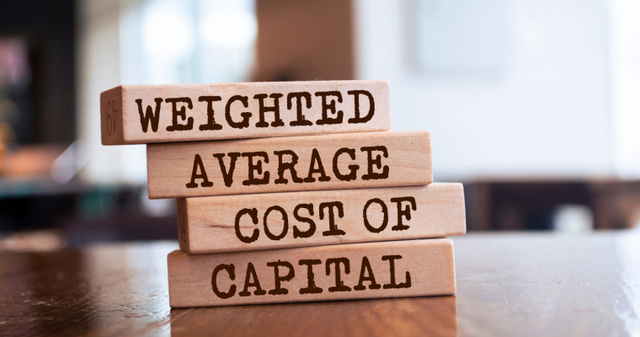
All the cash flows forecasted have to be discounted back to obtain the present value. For that, we need a discount rate. One of the option is to use the Weighted Average Cost of Capital (WACC), which is the weighted average cost of debt and equity capital. It may also be called the Cost of Capital
What is Weighted Average Cost of Capital (WACC)
The Weighted Average Cost of Capital (WACC) is the average rate of return required by both debt and equity investors. It considers the weightage of each component in the company's capital structure.
Understanding Weighted Average Cost of Capital (WACC)
The Weighted Average Cost of Capital (WACC) or cost of capital is a significant factor influencing valuation. It is determined not only by the business risk but also the financial risk associated with the company's capital structure. To calculate the cost of capital or discount factor, the following information is required:
- Capital Structure : The mix of debt and equity used to finance investments in fixed assets or working capital is known as the capital structure. It should align with the company's lifecycle and the industry it operates in.
- Cost of Debt : This represents the expense associated with borrowing capital. Debt is generally cheaper than equity due to its fixed claims on cash flows and tax deductibility of interest. However, it increases the financial risk and affects the cost of equity.
- Cost of Equity : It denotes the return expected by shareholders for investing in the company's equity. The cost of equity is influenced by factors such as market conditions, company performance, and investor expectations.
Capital structure decisions should be based on the company's lifecycle stage and industry type. Start-ups, early growth, and growth-stage companies often finance their growth through equity. In contrast, mature growth or mature companies may opt for debt financing to enhance shareholder returns.
Industry characteristics also influence the capital structure. Cyclical companies with unpredictable cash flows may rely more on equity financing to compensate for the business risk. Banking and insurance companies, on the other hand, often utilize significant amounts of debt in their business models.
Determining the Debt Equity Ratio is vital in understanding the company's growth financing. It should be calculated using market values rather than book values since investors focus on returns based on market valuation. For instance, if the market value of debt and equity is known, the Debt Equity Ratio can be computed accordingly to arrive at the discount rate.
Another aspect to consider is the market capitalization or estimated valuation of the company. Market capitalization represents the market value of a company's outstanding shares, calculated by multiplying the number of outstanding shares by the current market price per share. For private companies, the estimated latest valuation is often used, such as the valuation from the last funding round or an approximate estimate.
For example, if the book value and market value of debt and equity are as follows:
Thus, one should use 33% debt and 67% equity as the capital structure of the company to arrive at the discount rate.
By considering the capital structure, cost of debt, cost of equity, and relevant market information, a company can determine its Weighted Average Cost of Capital (WACC) or cost of capital. This information is instrumental in conducting accurate valuations and making informed financial decisions.
What is WACC Formula, Calculation, Excel and elements
For example, if a company’s pre-tax cost of debt is 10%, estimated cost of equity is 15%, income tax rate is 30%, and it finances its business growth by debt of 40% and equity of 60%, then the weighted averages cost of capital would be computed as follows:
| Particulars | Weight (%) | Cost (%) | Weighted (%) | Cost |
| Debt (After Tax) | 40 | 7 | 2.8 | |
| Equity | 60 | 15 | 9.0 | |
| Cost of Capital | 11.8 |
Note:
- Post tax cost of debt equals cost of debt x(1- tax rate) =10% x (1-30%) = 7%
- Cost of capital is also called Weighted Average Cost of Capital (WACC)
Calculating WACC
Example of Company X for Computing Weighted Average Cost of Capital (WACC)
We now compute the WACC for company X in Table 1 based on the following assumptions:
Assumptions
| Market Capitalization | 3000 |
| Debt | 1000 |
| Post Tax Cost of Debt x (1- tax rate) | |
| 8% x (1 - 25%) | 6% |
| Cost of Equity | 10.5% |
Table 1
Computation of Weighted Average Cost of Capital (WACC)
| Particulars | Weight | Cost | Weighted Cost | |
| Debt (Post Tax) | 1000 | 25% | 6% | 1.5% |
| Equity | 3000 | 75% | 10.5% | 7.87% |
| Cost of Capital / WACC | 4000 | 75% | 100% | 9.37% |
Thus based on the above computation, the cost of capital or WACC comes to 9.37%
Key Takeaways – Weighted Average cost of Capital

- Intrinsic value requires discounting forecasted cash flows to present value.
- WACC (Weighted Average Cost of Capital) combines debt and equity costs.
- WACC reflects average return expected by both debt and equity investors.
- Capital structure, cost of debt, and cost of equity influence WACC.
- Industry type and company lifecycle impact capital structure decisions.
- Debt Equity Ratio based on market values is crucial for discount rate.
- Market capitalization or valuation influences WACC calculation.
- WACC formula: WACC = (Weight of Debt * Cost of Debt) + (Weight of Equity * Cost of Equity).
Frequently Asked Questions

Who Uses WACC
The Weighted Average Cost of Capital (WACC) is a financial metric that is widely used by various stakeholders in the business and finance world. Some of the key users of WACC include:
- Companies and Corporations: Companies use WACC as a critical component in evaluating investment decisions and capital budgeting. It helps in determining the minimum rate of return a project or investment must achieve to create value for shareholders. Additionally, WACC is used to assess the cost of capital for specific financing options, such as debt or equity issuance.
- Investors and Shareholders: Investors and shareholders use WACC to assess a company's financial health and the risk-return profile of its investments. It helps in evaluating whether a company is generating sufficient returns to compensate for the risk associated with its capital structure.
- Analysts and Research Firms: Financial analysts and research firms use WACC to value companies and determine their intrinsic worth. WACC serves as a discount rate in various valuation models like discounted cash flow (DCF) analysis to estimate the present value of a company's future cash flows.
- Mergers and Acquisitions (M&A) Professionals: In M&A transactions, WACC is used to assess the cost of capital of the target company. It helps in determining the appropriate price to offer for an acquisition or to evaluate the attractiveness of a potential target.
- Credit Rating Agencies and Lenders: Credit rating agencies and lenders use WACC to assess a company's creditworthiness. A company with a lower WACC may be seen as less risky and more likely to meet its debt obligations, leading to better credit ratings and potentially lower borrowing costs.
- Regulatory Authorities: Some regulatory authorities may use WACC as part of their evaluation process, especially in industries with regulated pricing structures or in the assessment of investment projects.
- Management and Boards of Directors: Corporate management and boards of directors use WACC to evaluate the company's overall cost of capital and guide decisions related to financing, capital structure, and investment opportunities.
- Private Equity and Venture Capital Firms: These firms use WACC in their due diligence and valuation processes when considering investments in private companies or startups.
In summary, Weighted Average Cost of Capital is a widely utilized financial metric that plays a crucial role in corporate finance, investment analysis, and decision-making. Its application spans across various sectors and is instrumental in assessing the cost of capital and potential returns on investment for both companies and investors.
WACC vs RRR
WACC (Weighted Average Cost of Capital) and RRR (Required Rate of Return) are both financial metrics used to assess the attractiveness of an investment or project. However, they differ in their scope and application :
- Definition:
- WACC: WACC is a financial metric that represents the average rate of return required by a company's investors to compensate them for the risk associated with investing in the company's equity and debt. It considers the cost of equity and the after-tax cost of debt, weighted by their respective proportions in the company's capital structure.
- RRR: RRR, on the other hand, is the minimum rate of return required by an investor or decision-maker on a specific investment or project to justify undertaking the project. It is the threshold return that an investment must achieve to be considered financially viable.
- Scope:
- WACC: WACC is used at the company level and provides an indication of the overall cost of capital for the entire business. It is used in corporate finance for capital budgeting decisions, evaluating investment opportunities, and determining the cost of financing.
- RRR: RRR is applied to individual investment projects. It is specific to each investment and reflects the risk associated with that particular project.
- Calculation:
- WACC: WACC is calculated by taking the weighted sum of the cost of equity and the after-tax cost of debt, where the weights are the respective proportions of equity and debt in the company's capital structure.
- RRR: RRR is determined based on the specific risk profile of the investment. It may be derived using various valuation techniques, such as discounted cash flow (DCF) analysis, where the required rate of return is used as the discount rate to estimate the present value of future cash flows.
- Use in Decision-Making:
- WACC: WACC is used by companies to evaluate potential investment opportunities and to determine whether the return on a project exceeds the average cost of capital. If a project's expected return is higher than the WACC, it is considered financially beneficial for the company.
- RRR: RRR is used by investors and decision-makers to assess the viability of a specific investment. If the expected return on the investment meets or exceeds the RRR, it is considered worthwhile to proceed with the project.
In summary, WACC provides an overview of the company's overall cost of capital and is used in corporate finance and capital budgeting decisions. On the other hand, RRR is specific to individual investment projects and represents the minimum rate of return required to justify undertaking each project. Both WACC and RRR are important tools in financial analysis and decision-making, but they serve different purposes and are applied at different levels.
Limitations of WACC
While the Weighted Average Cost of Capital (WACC) is a widely used financial metric, it has some limitations and assumptions that may impact its accuracy and applicability in certain situations. Some of the key limitations of WACC include:
- Assumptions about Constant Capital Structure: WACC assumes a constant capital structure, meaning that the proportion of debt and equity in the company's capital remains unchanged over time. In reality, capital structures can fluctuate due to changes in financial leverage, new debt issuances, or equity dilution, which can affect WACC calculations.
- Market Value vs. Book Value: WACC uses the market values of equity and debt to calculate the weights. However, obtaining the market values can be challenging, especially for private companies or when market prices are volatile. In such cases, book values may be used, which may not reflect the true market values.
- Appropriate Risk-Free Rate: WACC incorporates a risk-free rate as the cost of debt. Choosing the appropriate risk-free rate can be subjective and may vary depending on the country or region under consideration.
- Difficulty in Estimating Cost of Equity: Calculating the cost of equity is complex, as it involves using different models like the Capital Asset Pricing Model (CAPM) or Dividend Discount Model (DDM). The assumptions made and data used in these models can impact the accuracy of the estimated cost of equity.
- Treatment of Taxes: WACC considers the tax shield effect of interest expenses by reducing the after-tax cost of debt. However, tax rates can vary over time and may not always align with the company's reported tax rates.
- Uniform Discount Rate for All Projects: WACC assumes a single discount rate for all projects, regardless of their risk profiles. This may not be appropriate when evaluating projects with significantly different risk levels.
- Ignores Non-Linear Relationship between Debt and Cost of Capital: WACC assumes a linear relationship between the amount of debt and the cost of capital. However, in reality, adding more debt can increase the cost of equity due to higher financial risk and perceived risk by investors.
- Short-Term vs. Long-Term Perspective: WACC may not be suitable for evaluating projects or investments with differing time.
- Horizons: The cost of capital for short-term projects may differ significantly from that of long-term projects.
- Dependence on Assumptions: WACC relies on various assumptions, such as growth rates, risk-free rates, and market risk premiums. Small changes in these assumptions can lead to significant variations in the calculated WACC.
Despite these limitations, WACC remains a useful tool in corporate finance and investment analysis. However, it is essential to be aware of its shortcomings and complement its use with other valuation techniques and qualitative analysis to make well-informed financial decisions.
